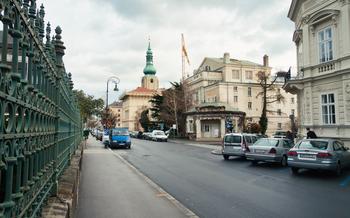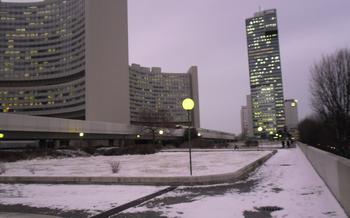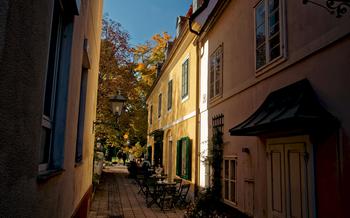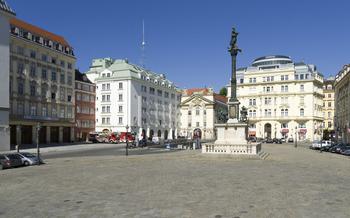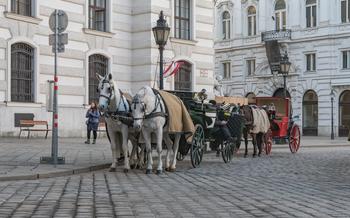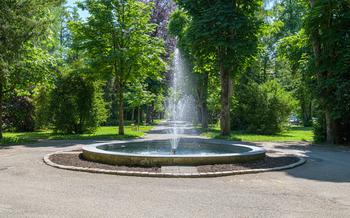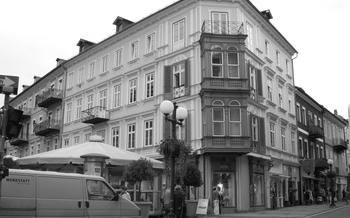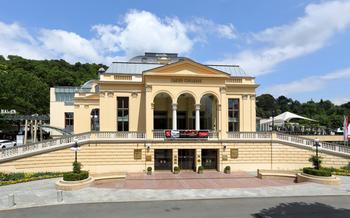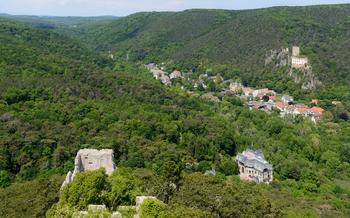
Kaiser Franz Josef Museum
- The Imperial Flair of Baden Bei Wien:
- Kaiser Franz Josef Museum
- Imperial Villa and Gardens
- Emperor Franz Josef's Personal Effects
- Imperial Documents and Correspondence
- Uniforms and Decorations
- Art and Portraits
- Temporary Exhibitions
- Educational Programs
- Research and Publications
- Museum Shop: A Treasure Trove of Imperial Memorabilia
- Visitor Information
- Getting There
- Nearby Attractions
- Insider Tip: Unveil the Secret Passage
The Imperial Flair of Baden Bei Wien:
Baden bei Wien, a charming town nestled on the outskirts of Vienna, Austria, exudes an imperial flair that transports visitors back in time. Steeped in rich history, the town served as a summer residence for the Habsburg dynasty, attracting royalty and nobility from across the empire. Its transformation into a popular spa destination in the 19th century further enhanced its allure, attracting visitors seeking relaxation and rejuvenation amidst its picturesque surroundings. Baden bei Wien proudly showcases its imperial heritage through its well-preserved architecture, elegant parks, and cultural attractions, inviting visitors to immerse themselves in the grandeur of a bygone era.
Kaiser Franz Josef Museum
The Kaiser Franz Josef Museum stands as a testament to the life and reign of Emperor Franz Josef I, the longest-serving monarch of the Austro-Hungarian Empire. Situated within the former imperial villa in Baden bei Wien, the museum offers a captivating journey through the history of this influential ruler.
The museum's collection features a diverse array of artifacts, documents, and memorabilia that provide an intimate glimpse into the emperor's personal life, political achievements, and cultural legacy. Visitors can marvel at personal items that belonged to Franz Josef, including his uniforms, medals, and decorations, gaining insights into his daily routine and his role as commander-in-chief.
Imperial documents and correspondence shed light on the emperor's decision-making process, diplomatic relations, and his interactions with his subjects. The museum also showcases a collection of paintings, sculptures, and portraits that capture the likeness of Franz Josef and his family, offering a glimpse into the artistic heritage of the period.
Imperial Villa and Gardens
The Kaiser Franz Josef Museum is housed within the stunning imperial villa, a testament to the grandeur of the Habsburg era. This magnificent building, constructed in the 19th century, served as a summer residence for Emperor Franz Josef I and his family. Visitors can wander through the villa's opulent rooms, admiring the intricate furnishings, elegant chandeliers, and exquisite artwork that adorn its interior. The villa's beautifully landscaped gardens, with their manicured lawns, colorful flower beds, and towering trees, provide a tranquil oasis in the heart of the town. These gardens, designed in the English style, offer a serene escape from the bustling city, inviting visitors to stroll along the winding paths, relax by the tranquil ponds, and soak in the beauty of the natural surroundings. The imperial villa and gardens, with their historical significance and architectural splendor, offer a glimpse into the lavish lifestyle of the Habsburgs and the grandeur of a bygone era.
Emperor Franz Josef's Personal Effects
The Kaiser Franz Josef Museum houses a remarkable collection of personal effects that once belonged to Emperor Franz Josef I, offering visitors a glimpse into his daily life and preferences. From his elegant uniforms and medals to his personal belongings, these artifacts provide a tangible connection to the man who ruled the Austro-Hungarian Empire for over 68 years.
One of the highlights of the collection is the emperor's iconic white military uniform, which he wore on numerous occasions, including his coronation in 184The intricate details and decorations on the uniform reflect the grandeur and opulence of the Habsburg court. Visitors can also admire the emperor's collection of medals and decorations, which recognize his achievements and contributions, both military and civilian.
Beyond his official attire, the museum showcases a variety of personal items that reveal the emperor's more private side. These include his writing desk and personal correspondence, which offer insights into his thoughts and feelings. Visitors can also see his collection of photographs, capturing moments from his family life and travels.
The preservation and display of these personal effects are of utmost importance, as they provide a tangible link to Emperor Franz Josef I and his era. By showcasing these artifacts, the museum allows visitors to connect with the emperor on a personal level and gain a deeper understanding of his life and reign.
Imperial Documents and Correspondence
The Kaiser Franz Josef Museum houses a significant collection of imperial documents, letters, and manuscripts that offer a glimpse into the reign of Emperor Franz Josef I. These documents provide invaluable insights into political decisions, diplomatic relations, and personal matters, shedding light on the complex historical context of the Austro-Hungarian Empire.
The museum's collection includes official decrees, diplomatic correspondence, and personal letters exchanged between the emperor and his family, advisors, and foreign dignitaries. These documents reveal the emperor's thoughts, concerns, and strategies as he navigated the challenges of ruling a vast and diverse empire.
The museum takes great care in preserving and cataloging these documents, ensuring their accessibility for research and education. Scholars and historians from around the world have utilized these resources to gain a deeper understanding of the political, social, and cultural dynamics of the period.
By showcasing these imperial documents, the museum provides visitors with a unique opportunity to connect with the past and gain a firsthand perspective on the life and reign of Emperor Franz Josef I.
Uniforms and Decorations
The Kaiser Franz Josef Museum showcases an impressive collection of military uniforms worn by Emperor Franz Josef I, reflecting his role as commander-in-chief of the Austro-Hungarian army. These uniforms, meticulously preserved and displayed, offer a glimpse into the emperor's military career and the grandeur of the Austro-Hungarian Empire.
Among the highlights of the collection is the emperor's ceremonial uniform, adorned with intricate gold embroidery, medals, and decorations. This uniform, worn on special occasions, symbolized the emperor's authority and prestige. Visitors can also admire the emperor's field uniforms, which he wore during military campaigns and inspections. These uniforms, often bearing the scars of battle, provide a tangible connection to the emperor's military leadership.
The museum also houses a collection of medals and decorations awarded to Emperor Franz Josef I in recognition of his achievements and contributions. These include the prestigious Order of the Golden Fleece, the highest honor bestowed by the Habsburg dynasty, and the Military Order of Maria Theresa, awarded for exceptional bravery and leadership in battle. These medals and decorations, displayed with pride, symbolize the emperor's military prowess and the esteem in which he was held by his contemporaries.
Art and Portraits
The Kaiser Franz Josef Museum houses a remarkable collection of paintings, sculptures, and portraits that depict Emperor Franz Josef I and his family. These artworks offer a glimpse into the artistic heritage of the period and provide insights into the emperor's personality and reign.
Visitors can admire the majestic portraits of Franz Josef I, capturing his likeness in various stages of his life. The museum also showcases portraits of the emperor's wife, Empress Elisabeth, and other members of the Habsburg family. These artworks reveal the artistic styles and techniques popular during the emperor's reign, from the formal and elaborate Baroque style to the more naturalistic and intimate styles of the 19th century.
Beyond portraits, the museum features a collection of paintings and sculptures that depict historical events and scenes from the emperor's life. Visitors can admire depictions of Franz Josef I's coronation, his military campaigns, and his travels throughout the Austro-Hungarian Empire. These artworks provide a visual narrative of the emperor's reign and offer insights into the social and political context of the period.
The collection of art and portraits at the Kaiser Franz Josef Museum is not only aesthetically pleasing but also historically significant. These artworks contribute to a deeper understanding of Emperor Franz Josef I's life, his reign, and the artistic heritage of the Austro-Hungarian Empire.
Temporary Exhibitions
The Kaiser Franz Josef Museum enriches the visitor experience by presenting a dynamic program of temporary exhibitions that explore diverse aspects of Emperor Franz Josef I's life and times. These exhibitions delve into specific themes and topics, offering visitors a deeper understanding of the historical context and broader impact of the emperor's reign.
Curated with expertise and attention to detail, these exhibitions showcase artifacts, documents, and artworks that provide unique perspectives on the emperor's personal life, political decisions, and cultural influences. The museum collaborates with scholars, historians, and artists to present engaging and thought-provoking exhibitions that appeal to a wide range of visitors.
Temporary exhibitions at the Kaiser Franz Josef Museum serve as a platform for new research and interpretations, shedding light on lesser-known aspects of the emperor's life and era. They also foster a sense of discovery and encourage visitors to engage with history in a dynamic and interactive way.
Whether exploring the emperor's role in diplomacy, his relationship with the arts, or the social and economic changes that shaped his reign, temporary exhibitions at the Kaiser Franz Josef Museum offer visitors a deeper immersion into the complexities and significance of this pivotal period in Austrian history.
Educational Programs
The Kaiser Franz Josef Museum recognizes the importance of education in preserving and disseminating historical knowledge. To that end, the museum offers a range of educational programs designed to engage and inspire visitors of all ages. Interactive workshops, guided tours, and lectures bring history to life, allowing visitors to immerse themselves in the era of Emperor Franz Josef I and gain a deeper understanding of his reign and its impact on Austrian history.
Families can embark on a journey through time with themed tours that cater to children's curiosity and imagination. School groups can participate in educational programs that align with their curriculum, fostering critical thinking and historical empathy. Lifelong learners can attend lectures by renowned historians and experts, delving into specific aspects of Emperor Franz Josef I's life and times.
The museum's educational programs have received positive feedback from visitors who appreciate the opportunity to engage with history in a meaningful way. The museum's commitment to fostering a deeper understanding of Emperor Franz Josef I's reign and its impact on Austrian history ensures that the museum remains a vibrant and relevant institution for generations to come.
Research and Publications
The Kaiser Franz Josef Museum is not only a repository of artifacts and memorabilia but also a hub for scholarly research and publications. The museum's research department, staffed by experienced historians and researchers, is dedicated to advancing the understanding of Emperor Franz Josef I's reign and its impact on Austrian history.
The museum's publications play a crucial role in disseminating research findings to a wider audience. These publications include scholarly journals, exhibition catalogs, and monographs that delve into various aspects of Emperor Franz Josef I's life and times. The museum collaborates with universities and research institutions to ensure the academic rigor and relevance of its research.
Through its publications, the Kaiser Franz Josef Museum contributes to the preservation of cultural heritage and the advancement of historical understanding. The museum's research and publications serve as valuable resources for scholars, students, and anyone interested in the history of Austria and the Habsburg dynasty.
Museum Shop: A Treasure Trove of Imperial Memorabilia
The Kaiser Franz Josef Museum houses a delightful museum shop that serves as a treasure trove of souvenirs and memorabilia inspired by the life and reign of Emperor Franz Josef I. Visitors can browse a wide range of items, including books, postcards, replicas, and unique gifts that capture the essence of the museum's collection.
The museum shop is a treasure trove of souvenirs and memorabilia related to Emperor Franz Josef I and his era. Visitors can browse a wide range of items, including books, postcards, replicas, and unique gifts inspired by the museum's collection. From intricately designed jewelry to replicas of imperial regalia, the museum shop offers something for every taste and budget.
By purchasing a souvenir from the museum shop, visitors not only take home a tangible reminder of their visit but also contribute to the museum's ongoing operations and educational programs. The revenue generated from the museum shop plays a vital role in supporting the museum's mission to preserve and showcase the legacy of Emperor Franz Josef I and his era.
Visitor Information
Planning a visit to the Kaiser Franz Josef Museum is a breeze. The museum's convenient location makes it easily accessible from Vienna and other major cities in Austria. Various transportation options are available, including public transportation routes such as buses and trains. For those driving, detailed directions are provided on the museum's website.
Once you arrive in Baden bei Wien, the museum is just a short walk from the city center. The museum's hours of operation are flexible, allowing visitors to choose a time that suits their schedule. Guided tours are available for a more in-depth experience, and reservations can be made in advance.
The museum is committed to providing a welcoming and inclusive environment for all visitors. Accessibility features, such as ramps and elevators, are in place to ensure that everyone can enjoy the museum's exhibits. Additionally, family-friendly facilities, such as a children's play area and stroller parking, are available.
To make the most of your visit, plan your itinerary in advance. The museum's website offers suggested itineraries that can be customized based on your interests and time constraints. Combine your visit to the museum with other attractions in Baden bei Wien, such as the thermal springs, parks, and historical sites, to create a well-rounded experience.
Getting There
Reaching the Kaiser Franz Josef Museum is a breeze, with various transportation options available from Vienna and other major cities. For those without their own transport, public transportation is a convenient option. Buses and trains connect the museum to Vienna and surrounding areas, ensuring easy access for visitors. Driving to the museum is also a viable choice, with well-maintained roads and clear signage guiding visitors along the way.
Once in Baden bei Wien, the museum's central location makes it easily accessible on foot or by bicycle. Visitors can take a leisurely stroll or cycle through the town's charming streets, enjoying the beautiful scenery and historical landmarks along the way. The museum's proximity to other attractions, such as the thermal springs and spa facilities, allows visitors to combine their visit with a relaxing and rejuvenating experience.
Nearby Attractions
Complement your visit to the Kaiser Franz Josef Museum by exploring the many other attractions that Baden bei Wien has to offer. Immerse yourself in the town's thermal spring culture at one of the renowned spas, where you can unwind in soothing waters and rejuvenate your senses. Take a leisurely stroll through the picturesque parks and gardens, such as the Kurpark or the Doblhoffpark, and admire the vibrant floral displays and tranquil atmosphere.
History buffs can delve deeper into Baden bei Wien's rich past at the Römermuseum, showcasing archaeological treasures from the Roman era, or the Stadtmuseum, which chronicles the town's development over the centuries. Art enthusiasts will delight in the collection of modern and contemporary art at the Museum gugging, housed in a former psychiatric clinic and offering a unique perspective on outsider art.
For a taste of Baden bei Wien's musical heritage, visit the Johann Strauss Museum, dedicated to the life and works of the renowned composer who spent summers in the town. Attend a concert at the Stadttheater Baden, a beautiful 19th-century theater that hosts a variety of performances, including opera, ballet, and drama.
Combine your cultural exploration with a revitalizing break at one of Baden bei Wien's charming cafés or restaurants. Indulge in delicious Viennese cuisine, savor a cup of coffee in a traditional coffee house, or enjoy a glass of wine at a gemütlich Heuriger, a local wine tavern.
Insider Tip: Unveil the Secret Passage
As you wander through the Kaiser Franz Josef Museum, keep an eye out for a hidden gem—a secret passageway leading to a private chamber once used by Emperor Franz Josef I for confidential meetings and personal contemplation. This hidden passage, known only to a select few, offers a glimpse into the emperor's private life and allows visitors to experience a sense of historical intrigue. Discover this secret passage and feel transported back in time as you imagine the emperor's footsteps echoing through the hidden corridors of the imperial villa.
